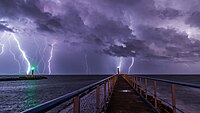
Photo from wikipedia
Using the data of 382 ground global navigation satellite system (GNSS) network stations in Western China, we studied and analyzed the ionospheric disturbances triggered by the “Long March” 2D rocket… Click to show full abstract
Using the data of 382 ground global navigation satellite system (GNSS) network stations in Western China, we studied and analyzed the ionospheric disturbances triggered by the “Long March” 2D rocket launch in Jiuquan, China on December 3, 2017. As compared with previous research, a higher sampling resolution for GNSS data (with a frequency of 1 Hz) was used to obtain more accurate occurrence times and propagation velocities of ionospheric disturbances. By using a method based on a quadratic function of time to fit a raw total electron content (TEC) series, a filtered TEC series was calculated using carrier observations, and a two-dimensional disturbances map was drawn. A new method, which accounts for the flight time of the rocket, was used to calculate the velocity of the shock wave. Ionospheric depletions and the shock wave were observed after the launch of the rocket. The depletion was observed within 100 to 1000 km south of the launch site along the rocket trajectory, which had a maximum amplitude of ∼3.8 TEC units (TECU), reaching ∼56% of the background TEC. A shock wave of V-shaped disturbances with amplitudes of ∼0.67 TECU was detected on both sides of the rocket trajectory. The shock wave moved southeast at an average velocity of ∼1861 m/s at a location 2200 km away from the launch site. Ionospheric disturbances with distances of more than ∼3000 km from the launch site were also observed.
Journal Title: IEEE Journal of Selected Topics in Applied Earth Observations and Remote Sensing
Year Published: 2023
Link to full text (if available)
Share on Social Media: Sign Up to like & get
recommendations!